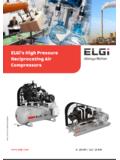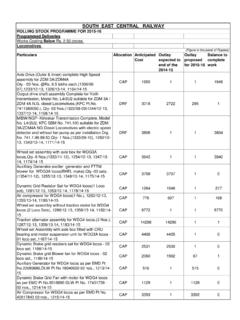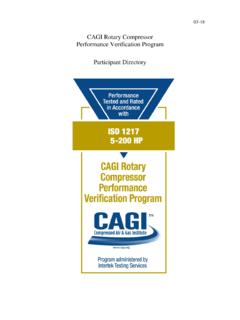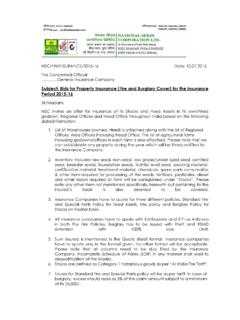Transcription of Introduction to Rheology of Lubricating Grease …
1 Introduction to Rheology of Lubricating Grease publication chapter 1. Introduction L. Hamnelid The History and Future of Lubricating Grease Lubrication has been necessary since the very dawn of human beings becoming intelligent enough to use tools with moving parts. When humans started moving things around, should it be stone blocks to build a pyramid or using a wheel-cart for transportation, a DE4S [pronounced "de-force"] (Dynamic Energy Saving Shearable Surface Separator), or in other words; a lubricant was needed to reduce the effort. Today lubrication of rolling and sliding parts in a construction is very much taken for granted. The principles of how lubricants work is unknown to most people.
2 It can also be presumed that the first practical application of lubricants was a coincidental discovery and not a direct innovation. As long as the speeds were low, simple vegetable oils or fats, sometimes even crushed snails, were sufficient for the friction reduction, if ice, snow or water did not already provide the necessary slipperiness. Over time, many developments have been made to improve transportation, but less to develop lubricants to meet their new demands. From the day of the first steam engines, lubrication has become even more important, the choice of the correct lubricant more difficult and the required lubricant properties more comprehensive.
3 The future will put ever-increasing demands on long life, higher speed, higher running temperatures and compatibility with the mechanical seals and the global environment. There is a great challenge for Lubricating Grease developers to find new products that will meet these requirements. This will be accomplished not only by the use of new types of materials but also by new and scientific ways to determine the necessary properties and abilities of modern Lubricating greases thus allowing the phasing out of products no longer able to meet the requirements. Fundamental research that can describe the basic principles of lubrication is still just in its infancy and is a great challenge for current and future researchers.
4 Conservative thinking within our business mitigates against change even though some specific types of Lubricating Grease are reaching the end of their useful life. Replacement of old conventional water-stabilised calcium greases is still a pending issue. If life cycle graphs for the product types were more frequently used within the business, it can be assumed that the actors in the market would get a rude awakening. ELGI Rheology Book publication 1 Many improvements have been made to the original concepts of Lubricating greases, but few, if any, real innovative "jumps" in the technology can be found. Since the early days of Clarence E. Earle s Introduction of the lithium greases [1], and especially when in combination with 12-hydroxy stearic acid as the anion, only the so-called complex greases are evidence of any innovation in the business.
5 The rest can better be described as incrementalism. Such an amelioration process is often driven by cost factors and availability of raw materials, rather than by a targeted development driven by fundamental research. Development is also normally made by "trial and error" since the complex nature of Lubricating greases is little understood and only a scarcity of fundamental knowledge about the chemistry and physics is accessible. Even worse, most of the test methods used today are of poor precision and often have little or no correlation to real life applications. A scientific approach to the use of products based on thickener technology has made it possible to develop many new and reliable products within many other business areas: polymers, cosmetics, paints, drugs and medicines, to mention a few examples of materials not too far removed from Lubricating greases.
6 The use of the cone penetration test method to measure the consistency of Lubricating greases and to try to find correlation to the actual rheological behaviour of a product is like trying to life-save a dying fish by the mouth-to-mouth method. The best way to get a description of consistency would be to use a direct rheological determination of the yield stress value, preferably within a period that correlates to practical use of Lubricating greases. The yield stress is also a possible value that could be used as a so-called engineering value. A value that is specific for certain types of materials and can be used for the selection of the right product for a given application by itself or, more likely, in combination with other engineering values.
7 Engineering values are frequently used in many areas of material specifications, lubricants not excluded. For a long time, the oil industry has been using specifications like SAE and ISO VG classes to simplify recommendation of appropriate oils for specific applications. A lot of effort has been spent on attempts to make a workable classification system for Lubricating greases, so far without too great a success. The complexity of Lubricating greases is definitely not best defined by empirical tests and the derived data put into a simplifying table. To make it possible to specify engineering values for Lubricating greases, an understanding and determination of fundamental physical properties must first be established.
8 The common resistance to change within our business is understandable considering the complex nature of Lubricating greases. If it is difficult to specify the real scientifically derived criteria, it is easy to stick to a set of empirically derived criteria that seem to fit for a given application. In practice, this way of reasoning will create problems for the user since it does not take into consideration the actual application parameters and the complex rheological and tribological behaviour of Grease . Lubrication is of utmost importance in modern society, not least in the impact on the natural environment. The use of proper lubrication will not only reduce costs, but also effect the natural environment in a positive way.
9 The contrary is of course also true. Demands for lower energy input when using a Dynamic Energy Saving Shearable Surface Separator, longer lifetime of machinery and the more efficient use of existing equipment, will all contribute to both the World Economy, as well as to a slower consumption of the non-renewable resources of ore and oil. ELGI Rheology Book publication 2By using an appropriate lubricant in any given application, the demand for the energy needed to drive the equipment can be reduced and the machinery can give a higher reliability (less standstill time for maintenance and unexpected breakdowns). The lifetime will be appreciably extended and effective output of the equipment increased.
10 There have been calculations made, which show that billions of dollars in savings every year could be made by changing to the appropriate lubricant for currently running equipment. Most lubricants are fluids, and most commonly, they are refined fractions of mineral oils. The yield of Lubricating oils from crude oil is about 3%. Today more highly refined and hydrotreated mineral oils are used. The polyaromatic compounds have been reduced to levels that, for the moment, are more environmentally acceptable. The development of new technology has increased the need for lubricants that can operate at higher speeds, loads, temperatures and more difficult surrounding environments for an increasingly longer lifetime.




